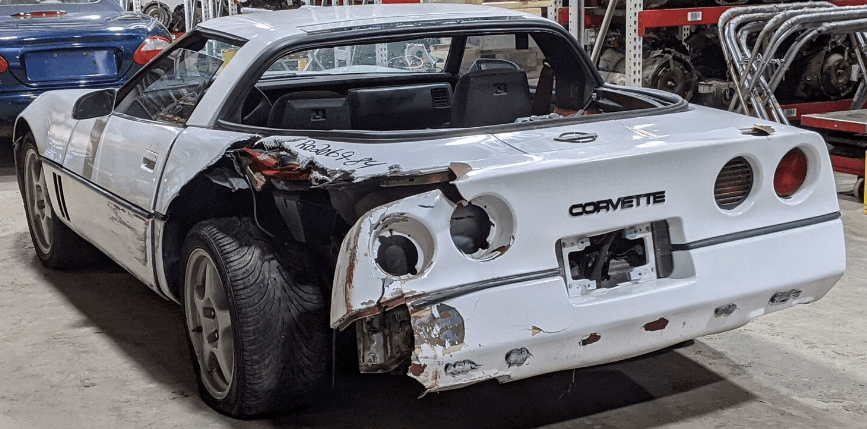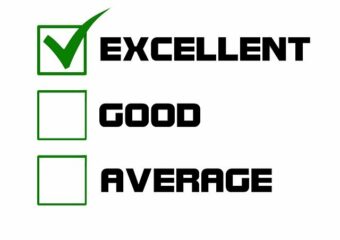
When making a purchase of a used automobile, you should assume there is some kind of condition issue. Because its a Corvette, it is easy to get caught up in the moment and find yourself the owner of a fiberglass POS. Just remember, this is a 30-year-old car we are talking about.
Although it isn’t possible to look at every item on the car there are some general guidelines that you should look for whenever you plan on purchasing a C4 Corvette or any Corvette for that matter. This Chevrolet Corvette Buying Guide isin’t meant to cover every issue that might pop up but its a good general guide for typical issues.
The best advice really is to take any used car to a repair shop that has good knowledge of your vehicle before you purchase it. If you do not know a Corvette expert, a repair shop that has similar knowledge will work. If you would rather look at it yourself below is a list of common items to check.
Repair Records
One of the good checks against buying a basket case is to ask if there are any service records available. If the C4 Corvette you are looking at has had only one or two owners, you may be able to get pretty much most of the history. If there has been a lot of owners, the last owner will probably have the receipts from the present service history. If they do not, its not necessarily a red flag, but it is definitely something to be cautious of. If there are no records and no leads on who has been maintaining the automobile, you will either have to thoroughly check everything on the vehicle or walk away from the potential purchase.
Also if the selling individual will disclose the shop that has been maintaining the automobile while they have owned it, you might get additional information there.
Let’s assume you have found a C4 Corvette that appears to be in good shape. What to look for in that situation is the question.
Appearance
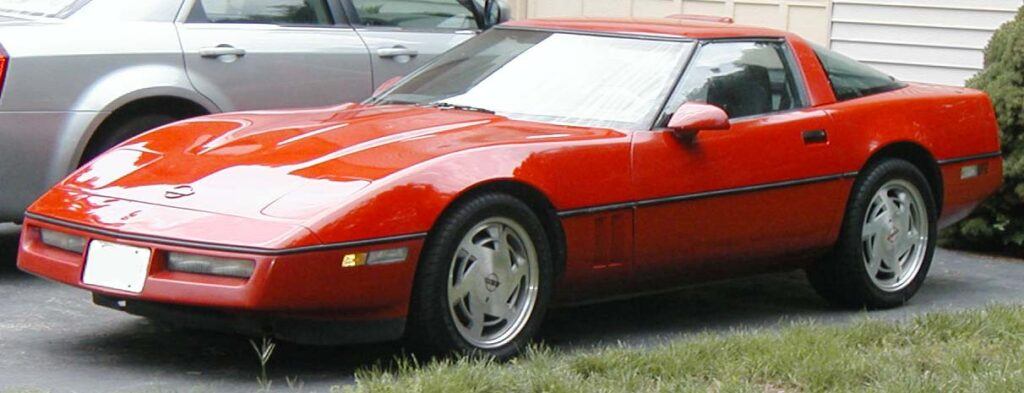
Everyone knows it is the looks of an automobile that first gets a potential buyer’s attention and if it looks good enough or is the right color, the buyer can be blinded to all other issues that the car might have.
So very, very true in the case of the Corvette.
Normally, a smart or seasoned seller will have the automobile detailed prior to selling. This really depends on the Corvette you are looking at. If its a low mileage or low production model this will be the case. If its fixer upper or in need of work this won’t likely happen. A detail shop will clean the engine compartment, the dash, the seats and the plastic trim. They will also wash and wax the exterior.
You should look at the weather strip material around the doors, the windshield and the back hatch. This is something I didn’t do when I bought mine and it turned out to be in bad shape. I had to replace a lot of it and I will detail that in the future. It is almost a certainty that some of it will be cracked but if all the strips are in bad shape, it will cost you several hundred dollars to replace everything yourself. Much more if you have someone do it for you.
Inside the Corvette
Look for areas of wear in the carpet, if there are floor mats, be sure to look under them for signs of wear. Also, look for signs of discoloration on the floor, this will indicate water leaks. Be sure to check the carpet in the back cargo area too. If there are leaks around the hatch there will be discolored carpet here as well.
Also in the rear cargo compartment, look for cracked or damaged trim, broken or damaged top hold down hardware and scratched or otherwise damaged plastic seat backs.
Finding these situations and pointing them out to the seller along with protestations that you will have to have things fixed will sometimes result in a lower price.
Past Damage
Many Corvettes have some sort of past damage. Most will be very minor but occasionally you run into some major problems usually caused by an accident. Before you spend your hard-earned money, take the time to make sure you are not buying something that was in a body shop or a junk yard during the Corvette’s past.
I think a Carfax or the like can point out some past issues but they are hit or miss on these old cars. They can be useful just don’t rely on them completely.
Check for fiberglass repairs, look at the underside of fenders, the inside of doors and inside the engine compartment. Also, look around the rear of the car including where gas is put in the gas tank.
One of the most important things to check is the frame. Frame repairs normally show discoloration, wrinkles or welding where the metal has been repaired.
You should never buy a Corvette that shows frame damage, or any car for that matter. Uneven tire wear, poor cornering, pulling to one side and even reduced safety are possibilities. It is just not worth it. Stand in front and behind the car and look at it. Does it look straight? A lot of times you can tell a frame is not straight by just looking at it.
Visual Inspection
If possible, go to where the car is located, do not allow the car to be brought to you. You really want to see how the engine starts when it is cold.
Check the tire tread and any signs of damage or uneven wear. Also, check the date code on the tires. Just because there is good tread doesn’t mean they are safe. Tires more than 10 years old should no longer be used. Something else to think about when deciding on the price you want to pay. The tires on my 85 had plenty of tread but were pretty old, its one of the first things I replaced after purchase.
Check the clam shell hood, is it easy to open and close? It should release and lift pretty easily. Just keep in mind it is heavy.
You can check the engine’s valve covers to see if the engine is cold and for oil leaks. Leaky valve covers are a common issue.
Look for discoloration or antifreeze on top of the engine next to the TPI. This is a good indication there is intake manifold leakage. This can indicate a couple different areas that need new gaskets. Is this something you want to tackle or repair?
Check for any loose fasteners or cables anywhere in the engine area.

Look all around for any signs of major oil leakage.
Do the plug wires have any cracking or burn type damage? I personally like to change out the plugs and wires when I first buy an older vehicle so depending on this might not really be a big issue for you.
Are any of hoses cracking or leaking? Are they connected correctly?
Does the belt look like its getting old and needs replacing?
Check one final time that the front end doesn’t have damage or issues.
Pull the dipstick and check the oil. If it has had a brand new oil change, be especially vigilant. This could be a sign the owner is trying to hide something.
Press each of the hatch release buttons to be sure the hatch works with no problems. It should spring up once the buttons are pushed. Close the hatch to check that it shuts correctly.
Check the security system. What to check for here really depends on what year you are looking at. For instance my 1985 did not include the VATS security system. If you are looking at one that does, you might want to get up to speed on learning how it works and what to check for.
I also like to ask the owner about certain things as I go along. it’s amazing what people will be honest about. Ask and listen, leaving some silent time after your question, makes some people nervous and they will tell you more than they meant to say.
The Engine
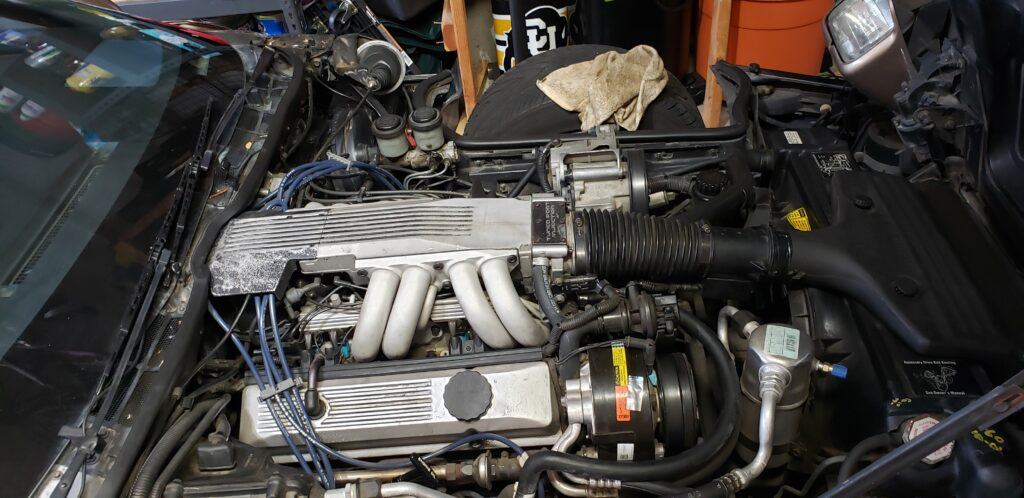
When starting the engine for the first time does it starts immediately (Within 2-3 seconds of cranking when cold).
There should be no clicking sound for more than a few seconds after start up.
If the engine is slow to start or needs help, there may be hidden engine problems. A knocking sound that continues for more than just a second or so could be rod bearing/lower end problems and possibly serious and expensive to repair.
When the engine starts, watch for any sign of smoke from the exhaust. Oil smoke can indicate problems with either the piston rings, the valve guides or both.
Hopefully the engine idles smooth. Put your hand near one of the exhaust pipes and feel for pressure. This is a basic test for a weak cylinder. and if you can detect instances where the pressure changes, there could be a cylinder with low compression.
Additional Mechanical Issues
The LCD, Digital Dash or Electronic Instrument Panel, were availble in the 1984-1989 models of the C4 Corvette. 1990 and later have a traditional instrument gauges and an LCD speedometer display.
Check all the power options work, door locks, seats and rear view mirrors for correct operation.
Check the instrument panel works. The LCD display should have equal lighting across the display. If the lighting varies, one or more of the expensive bulbs in the panel most likely burned out. Removing the dash and replacing the bulbs is something I have not had to tackle yet but it appears to be quite the process.
Check for a trip odometer mileage reading, remaining miles range and average MPG reading display on the Electronic Instrument. If there are no readings, its possible there are problems and a potential large repair bill. Turn on the parking lights and operate the headlamps. Check that both headlights rotate to the up and down position. Headlight flip issues are common with C4 Corvettes. They are not hard to fix, you just have to decide if you can live with it until a repair can be made.
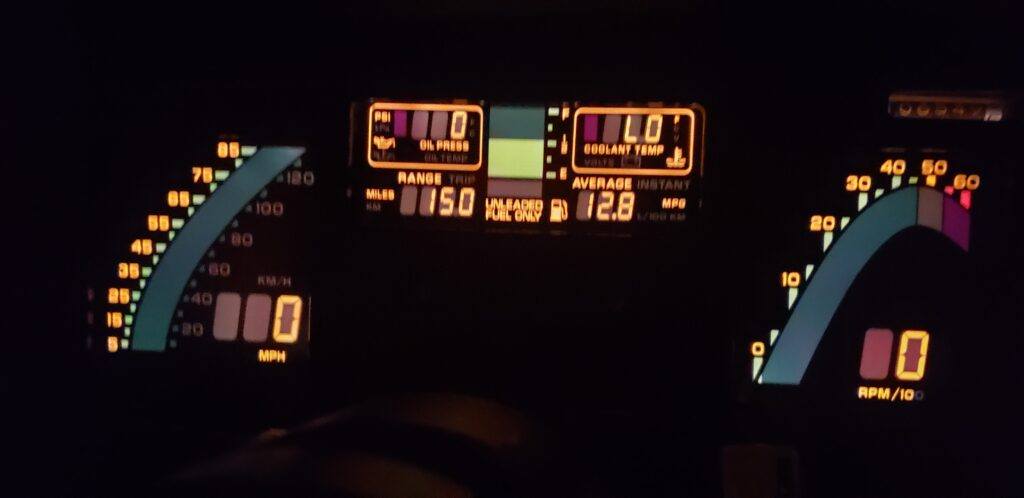
Block the light detector on the digital dash (it’s the small, clear window above the speedometer) and rotate the dimmer knob on the headlamp switch. The instrument panel should dim. If not, that’s another big repair bill to fix the issue.
With the key only in the on position, make sure all the lights come on especially the check engine light. People have been know to disconnect this light to hide issues that cannot be fixed or that the might not want a potential seller to know needs to be fixed. Be sure all the lights work but the check engine is the most important. You might want to check for any errors currently popping up. See my instructions for checking those diagnostic errors here.
Check that the turn signals and lights work.
Get the engine up to operating temperature: Check the idle oil pressure and temperature plus the coolant temperature.
Now get out of the car and if the Corvette is an automatic, pull the transmission dip stick. Make sure the transmission fluid is filled properly. If the car is a manual transmission, slowly engage the clutch while you listen for any chattering sound or feel a chattering on your foot through the clutch pedal.
Which type of manual transmission is it? There were 2 to choose from on the C4 Corvette.
It there is tendency for the car to lurch forward as the clutch is slowly engaged there could be a problem and possibly a slipping clutch.
Drivability
Obey all traffic laws and do not endanger yourself, anyone else or any property as you perform drivability testing.
With your foot on the brake, place the automatic transmission in a forward gear. Make sure no one is standing in front of you for safety. check for a delayed response to being placed in gear or unusual noises as the transmission engages.
Check the transmission in reverse for the same issues.
Drive the vehicle and pay attention to any unusual noises or slow responses. Look for erratic shifting in an automatic transmission by trying different types of acceleration. The shifts should be swift and sure no matter how easy or hard you get on the gas.
Look for possible syncro problems in a manual transmission. The shift points should go smoothly with no need to “double clutch” the gears while up or down shifting. Make sure that the vehicle rolls straight and doesn’t pull to one side or the other. In an area where it is safe to, accelerate and then apply the brakes as in a panic stop. The car should stop straight it shouldn’t pull to one side or the other.
Accelerate again and do a gentle stop listening for the shrill sound that indicates that the wear limits on the brake pads has been exceeded.
Final Checks
If you are able, inspect the underside whether on a lift or just looking under the vehicle the best you can.
Inspect the underside for any signs of engine oil or transmission fluid leakage that you might have missed while looking at the engine. Just about any 30-year-old engine can leak a little but a large leak is cause for concern. Check the rear axle to make sure it is also not leaking.
Make sure the suspension doesn’t have broken or damaged components. Also inspect the shock absorbers for any sign of fluid leakage or possible problems.
Look at the exhaust for damage or missing parts, carefully look at the exhaust manifolds for any signs of cracking or damage. Also, check the pipes, catalytic converter and mufflers. The cat is very expensive to replace. Depending on the emissions laws where you live this can be even more important and costly.
Are the spare tire and jack present?
Conclusion
Something else worth considering, why is the owner selling the car? Looking for a fixer upper, known issues the owner tells you about is OK, but they probably won’t tell you everything. Looking for a daily driver or something you don’t want to work on? Make sure you are aware of anything that can cause issues for what you want with your C4 or what you don’t want.
Another thing, what’s your gut tell you? If you’re just not comfortable with the whole thing just walk away. Feel the seller is not truthful? You can always walk away. It’s your money, you make the final choice. I didn’t buy mine the first time I looked at it. I needed to consider it overnight before making the final decision. Don’t change your normal purchasing process just because you are excited to get a Corvette.
There will be more C4’s to check out. I personally only wanted a few things for certain, manual transmission, good paint job I didn’t need to fix, and that was it. That way I could be more flexible with everything else I was looking at to make sure I get the best deal for me I could find.

